Intrarenal arterial administration of human umbilical cord-derived mesenchymal stem cells effectively preserved the residual renal function of diabetic kidney disease in rat
- PMID: 35526048
- PMCID: PMC9080206
- DOI: 10.1186/s13287-022-02857-5
Intrarenal arterial administration of human umbilical cord-derived mesenchymal stem cells effectively preserved the residual renal function of diabetic kidney disease in rat
Abstract
Background: This experimental study was designed as a preclinical study for testing the hypothesis that intrarenal arterial (IRA) transfusion of human umbilical cord-derived mesenchymal stem cells (HUCDMSCs) therapy preserved the residual renal function of diabetic kidney disease (DKD) in rat [induction by 5/6 nephrectomy of left kidney and right nephrectomy, followed by intraperitoneal administration of aminoguanidine (180 mg/kg) and streptozotocin (30 mg/kg)].
Methods: Animals (n = 24) were categorized into group 1 (sham-operated control), group 2 (DKD), group 3 [DKD + HUCDMSCs (2.1 × 105/IRA injection at day 28 after CKD induction)] and group 4 [(DKD + HUCDMSCs (6.3 × 105/IRA injection)].
Results: By day 60 after DKD induction, the kidneys were harvested and the result showed that the creatinine level, ratio of urine protein/urine creatinine and kidney injury score were lowest in group 1, highest in group 2 and significantly lower in group 4 than in group 3 (all p < 0.0001). The protein expressions of apoptotic (cleaved caspase-3/cleaved PARP/mitochondrial Bax), fibrotic (TGF-ß/p-Smad3), autophagic (ratio of LC3B-II/LC3B-I, Atg5/Beclin-1), oxidative stress (NOX-1/NOX-2/oxidized protein/p22phox), mitochondrial/DNA-damaged (cytosolic-cytochrome-C/DRP1/γ-H2AX) and inflammatory (MMP-9/TNF-α/p-NF-κB) biomarkers exhibited an identical pattern, whereas the protein expressions of angiogenesis factors (CD31/vWF/vascularity) exhibited an opposite pattern of creatinine level among the groups (all p < 0.0001). Histopathological findings demonstrated the renal tubular-damaged (KIM-1)/kidney fibrosis area/oxidative stress (8-OHdG + cells) expressed an identical pattern, whereas the podocyte components (ZO-1/synaptopodin/podocin) exhibited an opposite pattern of creatinine level among the groups (all p < 0.0001). No tumorigenesis or immune rejection event was identified.
Conclusion: IRA injection of xenogeneic MSCs was safe and effectively protected the residual renal function and architectural integrity in DKD rat.
Keywords: Diabetic CKD; Renal function; Xenogeneic mesenchymal stem cell.
© 2022. The Author(s).
Conflict of interest statement
All authors have read the journal’s policy on disclosure of potential conflicts of interest and the journal’s authorship agreement. The authors declare that they have no conflicts of interest. The article has been reviewed and approved by all named authors.
Figures
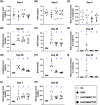
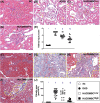
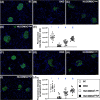
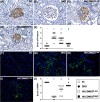
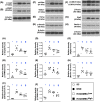
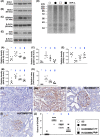
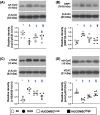



Similar articles
-
Repeated administration of adipose-derived mesenchymal stem cells added on beneficial effects of empagliflozin on protecting renal function in diabetic kidney disease rat.Biomed J. 2024 Apr;47(2):100613. doi: 10.1016/j.bj.2023.100613. Epub 2023 Jun 22. Biomed J. 2024. PMID: 37355087 Free PMC article.
-
Early and Dose-Dependent Xenogeneic Mesenchymal Stem Cell Therapy Improved Outcomes in Acute Respiratory Distress Syndrome Rodent Through Ameliorating Inflammation, Oxidative Stress, and Immune Reaction.Cell Transplant. 2023 Jan-Dec;32:9636897231190178. doi: 10.1177/09636897231190178. Cell Transplant. 2023. PMID: 37592717 Free PMC article.
-
Prion Protein Overexpression in Adipose-Derived Mesenchymal Stem Cells (ADMSCs) Effectively Protected Rodent Kidney Against Ischemia-Reperfusion Injury Via Enhancing ATP/Mitochondrial Biogenesis-Role of ADMSC Rejuvenation and Proliferation.Cell Transplant. 2023 Jan-Dec;32:9636897231211067. doi: 10.1177/09636897231211067. Cell Transplant. 2023. PMID: 38078417 Free PMC article.
-
Therapeutic role of mesenchymal stem cells (MSCs) in diabetic kidney disease (DKD).Endocr J. 2022 Oct 28;69(10):1159-1172. doi: 10.1507/endocrj.EJ22-0123. Epub 2022 Jul 20. Endocr J. 2022. PMID: 35858781 Review.
-
The therapeutic effect of mesenchymal stem cells in diabetic kidney disease.J Mol Med (Berl). 2024 Apr;102(4):537-570. doi: 10.1007/s00109-024-02432-w. Epub 2024 Feb 29. J Mol Med (Berl). 2024. PMID: 38418620 Free PMC article. Review.
Cited by
-
Placental Mesenchymal Stem Cells Alleviate Podocyte Injury in Diabetic Kidney Disease by Modulating Mitophagy via the SIRT1-PGC-1alpha-TFAM Pathway.Int J Mol Sci. 2023 Feb 28;24(5):4696. doi: 10.3390/ijms24054696. Int J Mol Sci. 2023. PMID: 36902127 Free PMC article.
-
What's New in the Molecular Mechanisms of Diabetic Kidney Disease: Recent Advances.Int J Mol Sci. 2022 Dec 29;24(1):570. doi: 10.3390/ijms24010570. Int J Mol Sci. 2022. PMID: 36614011 Free PMC article. Review.
-
Addition of adipose tissue-derived mesenchymal stem cells improves empagliflozin therapy for alleviating hyperglycemia--induced neuropathy.Am J Transl Res. 2023 Oct 15;15(10):6264-6285. eCollection 2023. Am J Transl Res. 2023. PMID: 37969202 Free PMC article.
-
Mesenchymal Stem Cell Therapy: Therapeutic Opportunities and Challenges for Diabetic Kidney Disease.Int J Mol Sci. 2024 Sep 30;25(19):10540. doi: 10.3390/ijms251910540. Int J Mol Sci. 2024. PMID: 39408867 Free PMC article. Review.
-
Protective effect of compound K against podocyte injury in chronic kidney disease by maintaining mitochondrial homeostasis.Sci Rep. 2025 Jan 2;15(1):435. doi: 10.1038/s41598-024-84704-6. Sci Rep. 2025. PMID: 39748100 Free PMC article.
References
-
- Aranson NJ, Lancaster RT, Ergul EA, Conrad MF, LaMuraglia GM, Kwolek CJ, Cambria RP, Patel VI. Chronic kidney disease class predicts mortality after abdominal aortic aneurysm repair in propensity-matched cohorts from the medicare population. Ann Surg. 2016;264:386–391. doi: 10.1097/SLA.0000000000001519. - DOI - PubMed
-
- Metra M, Nodari S, Parrinello G, Bordonali T, Bugatti S, Danesi R, Fontanella B, Lombardi C, Milani P, Verzura G, Cotter G, Dittrich H, Massie BM, Dei Cas L. Worsening renal function in patients hospitalised for acute heart failure: clinical implications and prognostic significance. Eur J Heart Fail. 2008;10:188–195. doi: 10.1016/j.ejheart.2008.01.011. - DOI - PubMed
-
- Cowie MR, Komajda M, Murray-Thomas T, Underwood J, Ticho B, Investigators P. Prevalence and impact of worsening renal function in patients hospitalized with decompensated heart failure: results of the prospective outcomes study in heart failure (POSH) Eur Heart J. 2006;27:1216–1222. doi: 10.1093/eurheartj/ehi859. - DOI - PubMed
MeSH terms
Substances
LinkOut - more resources
Full Text Sources
Medical
Research Materials
Miscellaneous

